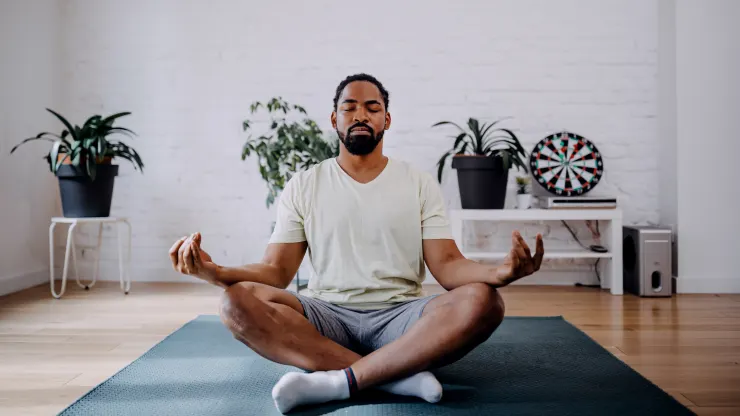
13 Jul Vipassana Meditation (Yoga in Heston)
Vipassana, which means “insight” or “clear seeing,” is one of the oldest forms of meditation, rooted in the teachings of the Buddha over 2,500 years ago. Unlike other meditation techniques that aim to calm the mind, Vipassana is about self-transformation through self-observation. It helps practitioners to see things as they truly are, leading to a deeper understanding of the nature of existence and the path to liberation from suffering. This article explores how to practice Vipassana meditation, providing a detailed guide to help you embark on this transformative journey.
Understanding Vipassana Meditation
The Philosophy Behind Vipassana
Vipassana meditation is based on the principle that suffering stems from ignorance about the nature of reality. By cultivating mindfulness and insight, one can break free from the cycle of craving and aversion, leading to inner peace and enlightenment. The practice involves observing bodily sensations and mental processes without attachment or judgment, fostering a direct experiential understanding of impermanence, suffering, and non-self.
The Benefits of Vipassana
Practicing Vipassana can bring about profound physical, mental, and spiritual benefits:
- Mental Clarity: Enhances focus and concentration.
- Emotional Balance: Reduces stress, anxiety, and depression.
- Self-Awareness: Deepens understanding of oneself and one’s reactions.
- Compassion: Cultivates kindness and empathy towards oneself and others.
Preparing for Vipassana Meditation
Setting Up a Meditation Space
Creating a conducive environment for meditation is crucial:
- Quiet Space: Choose a quiet, clean, and comfortable space where you won’t be disturbed.
- Minimal Distractions: Remove any distractions, including electronic devices.
- Comfortable Seating: Use a cushion, chair, or meditation bench that allows you to sit comfortably for extended periods.
Establishing a Routine
Consistency is key in Vipassana practice:
- Regular Schedule: Set aside a specific time each day for meditation.
- Duration: Start with 10-15 minutes and gradually increase to an hour or more.
- Patience: Understand that progress may be slow and requires patience and perseverance.
The Technique of Vipassana Meditation
Posture and Breathing
- Posture: Sit comfortably with your back straight but relaxed. You can sit cross-legged on a cushion or on a chair with your feet flat on the floor.
- Hands: Rest your hands on your lap or knees, with palms facing up or down.
- Eyes: Close your eyes gently or keep them slightly open with a soft gaze.
- Breathing: Focus on natural breathing. Do not try to control it; simply observe the breath as it is.
Initial Focus: Anapana Meditation
Before delving into Vipassana, it’s helpful to practice Anapana meditation (mindfulness of breathing):
- Observation: Focus your attention on the breath entering and leaving the nostrils.
- Sensation: Notice the sensation of the breath at the nostrils or the rising and falling of the abdomen.
- Awareness: If your mind wanders, gently bring it back to the breath without judgment.
Transition to Vipassana
Once you’ve settled the mind with Anapana, transition to Vipassana:
- Body Scan: Begin at the top of your head and slowly move down to your toes, observing sensations in each part of the body.
- Sensations: Pay attention to sensations such as tingling, pressure, heat, cold, itching, or pain. Acknowledge each sensation without reacting to it.
- Impermanence: Understand that all sensations are transient; they arise and pass away. This insight into impermanence is central to Vipassana.
Deepening Your Practice
Developing Equanimity
Equanimity, or mental calmness and evenness of temper, is crucial in Vipassana:
- Non-Reaction: Observe sensations without craving pleasant sensations or averting unpleasant ones.
- Acceptance: Accept all sensations as they are, recognizing their impermanent nature.
- Detachment: Maintain a detached awareness, allowing sensations to come and go without becoming attached.
Mindfulness in Daily Life
Vipassana is not confined to formal meditation sessions; it extends to daily life:
- Awareness: Stay mindful of your thoughts, emotions, and actions throughout the day.
- Presence: Engage fully in each moment, whether you’re eating, walking, working, or resting.
- Reaction: Notice your reactions to situations and strive to respond with equanimity rather than habit.
Common Challenges and Solutions
Physical Discomfort
- Adjusting Posture: Ensure your sitting posture is comfortable and adjust as needed.
- Mindfulness of Pain: Observe pain or discomfort as another sensation, noting its impermanence.
- Gradual Increase: Gradually increase meditation duration to build physical endurance.
Mental Restlessness
- Gentle Refocusing: When the mind wanders, gently bring it back to the present moment without frustration.
- Counting Breaths: If concentration is difficult, count breaths from one to ten and start over.
- Short Sessions: Start with shorter sessions and gradually increase the length as your concentration improves.
Emotional Turbulence
- Acceptance: Acknowledge emotions as they arise without judgment.
- Observation: Observe the physical sensations associated with emotions.
- Professional Support: If deep-seated emotions surface, consider seeking support from a therapist or meditation teacher.
Advanced Practices and Retreats
Attending a Vipassana Retreat
Vipassana retreats offer an immersive experience to deepen your practice:
- 10-Day Courses: Typically, Vipassana retreats are 10 days long, providing intensive practice under guidance.
- Noble Silence: Participants observe noble silence, refraining from speaking, reading, writing, or using electronic devices.
- Structured Schedule: The day is structured with periods of meditation, rest, and mindful activities.
Integrating Insights
Advanced practitioners work on integrating insights gained from meditation into their daily lives:
- Mindfulness: Maintain continuous mindfulness in all activities.
- Compassion: Develop loving-kindness and compassion for all beings.
- Wisdom: Cultivate wisdom by reflecting on the impermanent and interdependent nature of existence.
Conclusion
Practicing Vipassana meditation is a transformative journey that requires dedication, patience, and perseverance. By cultivating mindfulness and insight, one can attain a deeper understanding of the true nature of reality and achieve inner peace and liberation from suffering. Whether you’re a beginner or an advanced practitioner, the key is to approach the practice with an open mind and a sincere heart, allowing the profound benefits of Vipassana to unfold naturally in your life.

No Comments